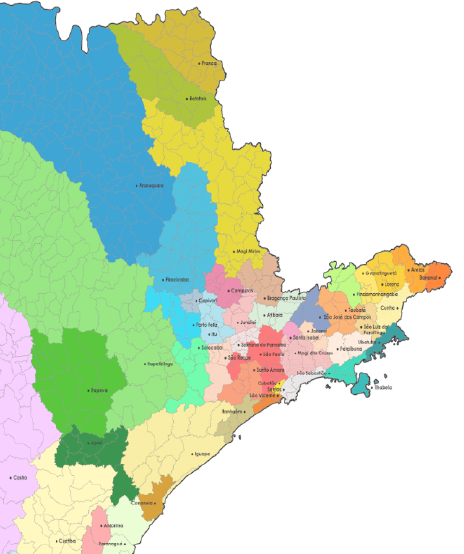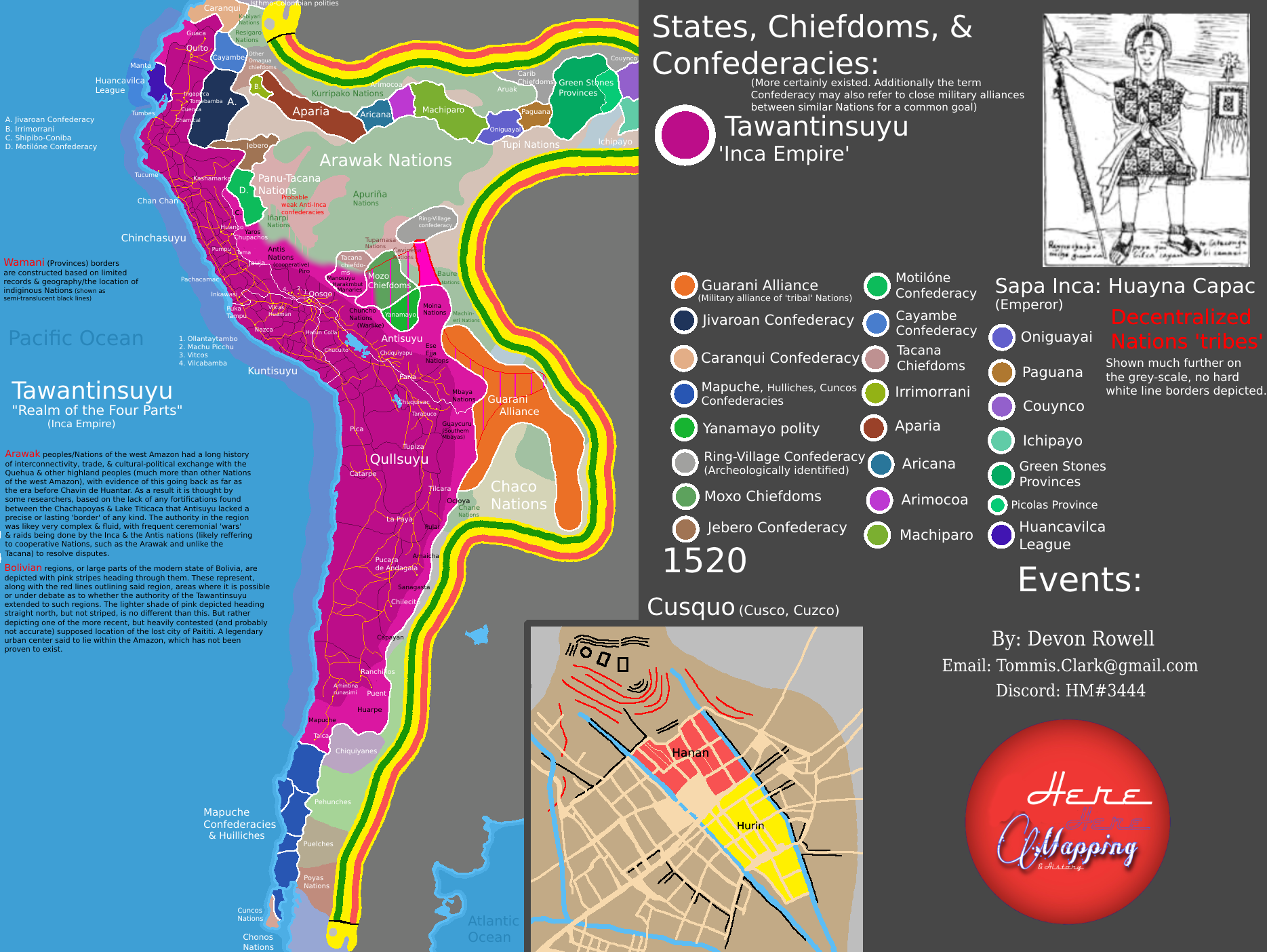Let me know your opinion.
I find that the current situation, as much as so little has been shown, it's bad enough for good feedback to be already at-work, so it's great to see this thread up (i was thinking on opening something like that myself, but due to uni commitments was postponing it repeatedly), there's a lot that can be made and determined before Paradox discloses their "current" version (Tinto Maps Brazil probably will take a lot of time, or any Tinto Maps on America for that purpose), and there's a lot to be discussed.
Since this thread is up, soon enough (probably next week, after my exams are over) i will contribute to this with my musings, mostly over demography (the whole American continent must have given the devs hell in the "numbers" department, haha), cultures (There's A LOT that Paradox can get wrong, especially in Brazil, due to the rather recent nature of the Tupi-Guarani migrations) and tags (Brazil will be a great opportunity to delineate what i think should be SoPs vs. "Tribal" gov settled countries). Most of the demography stuff will come from my research on Native American historical demography that i did for my Scientific Methodology class last year, Brazil was supposed to be a big part of that research (because, uh, lol, i am Brazilian, even though nothing about my profile gives that up) but it quickly ballooned out of my finish-until-deadline writing capacity and i restricted it to only the Caribbean...So i ended up digging a lot of sources and discussions up, and lining all of them up in my notes, for nothing...Now they will be useful! (Or at least my sunk-cost-hurting heart hopes so).
The biggest issue is that we don't really have something to compare to, as Brazil is mostly native land for at least half the game while every Tinto Map until now has covered settled lands. "but what about Africa" the partition of Africa happened after 1840, but a lot of Brazil was settled by then. So we have Europe and we have Africa, but not the middle ground.
That's my main issue with location-map construction before Paradox actually post the maps, even if the map is
wrong, the map gives valuable information as to the intent of
how Tinto wants its "right", my guess is that coastal location density should be bigger than the interior (duh), with location size increasing towards the interior quicker in the Northeast than in the Southeast (because well, Minas Gerais and São Paulo should be location-denser than, whatever, Espirito Santo), the South's (and the North's) locations shouldn't be compared to those of the rest of Brazil, but to their neighbouring regions' (La Plata and the non-Brazilian Amazon) because they will be bound by the 3x rule Tinto is broadly applying for location-size flow.
So we'd have a general South America pattern where locations are denser in the coast, become bigger in the
Sertão and
Cerrado, and then dense-fy again as it nears the Upper Plata Basin and the Andes, the latter being i would guess the most location-dense region of South America in the game. Due to the 3x rule, we'd probably be getting a "denser-than-expected" Paraguay River Valley and Andean Amazon for the sake of location consistency (a similar thing may happen in the
Cerrado states neighbouring Minas and São Paulo), a fact that can be exploited for the good of greater historical accuracy.
but I couldn't help but notice that there are more wastelands in southern Brazil than I was expecting.
TBH, as a very brazilian Brazilian (lmao), these wastelands kinda baffled me as well, not in their existence, but in their
size, half of the South region as an "uninhabitable wasteland" isn't exactly accurate by any metric, specially considering that it is the most "european-settlement-friendly" region in the entire country.
Something I was looking into more was which settled countries we might expect to be in Brazil at the 1337 start date. One of the obvious choices is the
Marajoara society at Marajó Island at the mouth of the Amazon river. According to the religion map above, it looks like at least most of the island isn't a wasteland. Another choice worth looking into are the cities built by the Kuikuro people in the Upper Xingu region. Based on archaeological sites like
Kuhikugu, these were very large settlements with thousands of people! I haven't mapped them on to know for sure, but I'm guessing and hoping that the Xingu cities are in one of the inhabitable areas on the map.
Another part of the map that is currently lacking is around the Amazon River. From the limited amount that I've seen from searching online, there were several large chiefdoms that controlled the banks of the river. Some maps that people have made online to show these chiefdoms are located
here on Reddit by Flat-Ad-2492 and
here on DeviantArt by AztlanHistorian. Hopefully the devs can expand the habitable areas around the Amazon River at least a little bit to be more like the maps below.
The Marajoara should definitely be a settled tag (or tags, in the plural, maybe?), i wonder what exactly that Marajó wasteland represents? I don't remember there being anything wasteland-worthy in the island itself. Anyway, besides that, and the Xingu cities, i would argue that most Tupi tribes should be settled "Tribe" tags, but i will elaborate further on that later.
The Amazon Basin's giant wasteland didn't exactly shock me (especially considering how that region works in EU4), but it certainly is something to be
fixed, since much of that wasteland was actually settled
by Europeans in the game's timeframe...Not extensively, of course, but settled nonetheless. This is without even considering the great opportunity Paradox would have of putting the on-the-academic-spotlight Amazonic societies into the game, if they model the region properly. At the bare minimum one should be able to trace Pizarro's route in the actual location map (so there should be a way to go from Peru to the mouth of the Amazon).
First of all, awesome contribuitions, I really hope that PDX take them into account whenever they are working in the area!
Giving my two cents on the theme, I would LOVE to see the Serra do Mar being mostly one contiguous wasteland with some unsettleable but crossable corridors, similar to what has been implemented in the Sahara.
Off the top of my head, two key crossing points between the coastal and the inland regions of Paraná were the (now known as) Itupava Path and Graciosa Road, which seem to have been used as paths by the indigenous peoples of the region, and would later be the main paths for the Tropeiros crossing the region starting in the 1700s.
Do I think those exact path would have necessarily been used by the indigenous people of the 1300s? No, but they do make sense to be present in later years, and are somewhat historically accurate, given that the indigenous peoples living in the two regions did in fact show evidences of trade interactions, but not many territorial disputes - giving the impression of those "trade corridors" having existed.
Anyways, if if not necessarily strictly historical, those corridors would be a gerta gameplay impplementation, both for a not to probable but still possible native start, and also for the colonial game later on!
Again, most of those ideas came off of my memory at htis time, so might not be 100% accurate, but I do want to contribute more to this discussion!
Also, I would love if PDX would be able to tell us which sources they have mostly been using for the region! It would surely avoid a lot of "double work" on the side of people aiming to contribute and help!
AFAIK the Natives actually using it in the 1300s is irrelevant – Although they probably did, since most
Bandeira routes were native-inherited, and it's quite rare for people to just...Switch their mountain routes, it's hard enough to find your way through a mountain, why would you
give up a path? – Tinto's criteria for corridors and mountain passes has been basically: People used it? Is it possible to
army through it? If both questions are answerable with a "yes", it is deemed acceptable. And the answer for the Serra do Mar roads are both yes (
Bandeirantes count as army enough for me, at least...).
~2.jpg)

.png)





~2.jpg)

.png)














